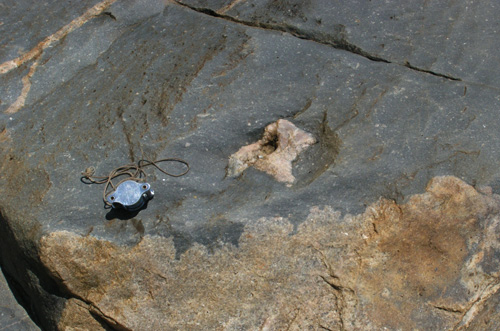I was particularly interested to hear everyone’s ideas about last Friday’s mystery outcrop, as I’m not entirely sure myself about precisely what’s going on. Here’s what I observed at the time:

- This locality is in the Johannesburg Dome – a complex of 3.1 billion year-old granites which are intruding an even older granite-greenstone belt (like the Barberton, but much more restricted in area).
- In this particular outcrop, a patch of dark, fine-grained mafic igneous rock, 5-10 metres across, is found within the coarser granite (sorry for the lack of a wide shot). This is the only such feature in the area – it is completely surrounded by granite.
- The contact between the two igneous rock types is quite sharp, but also has a fairly irregular topography in many places, with lobes of the mafic rock pushing out into the granite and vice-versa. You also see inclusions of one rock type incorporated within the other. This interaction strongly suggests that we are seeing the mingling of two melts, each with a different enough density and/or viscosity that even when they are mixed together they will not easily homogenise (just like oil and water). In other words, we have a mafic magma and a granitic magma both interacting within the same chamber.
- Both lithologies are cut by pegmatite veins (in the top left of the picture above). Pegmatite is a very coarse intrusive rock; it is thought to represent the final dregs of magma left over once most of the granite has crystalised, which are injected through cracks and cooling joints at the very end of the intrusive event. Again, this suggests the mafic material was incorporated into the granitic magma at an early stage.
The big question is, where did the mafic stuff come from? There are two main possibilities
- It was derived from a separate basaltic melt source, and got into the granite intrustion in an incident of mixed magmatic plumbing.
- It is actually a xenolith – a bit of the greenstone basement incorporated into the granite during melt injection. The mingling is a result of the basement material being heated up enough that it can deform.
At the time I was at the outcrop, I was favouring the second option. The edge of the granite does come into contact with greenstone basalts quite close by, and the boundary was not always as mixed up as in the pictures above – in places, it was quite straight and linear. Thinking about it now, though, I’m not so sure – if this were the case, wouldn’t we expect to see more alteration and recrystallisation around the edges of the mafic blob? Perhaps someone with more igneous expertise will let us know.



Comments (4)